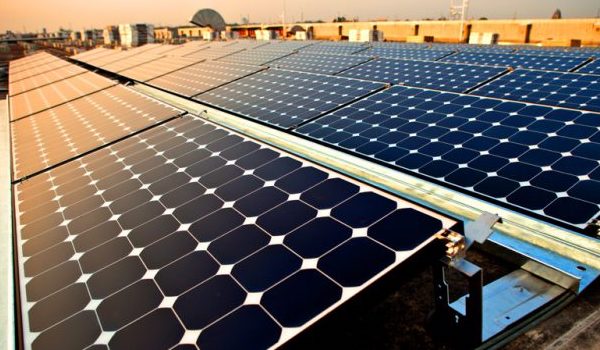In California we have been relatively lucky. As home or business owners we have been free to buy our own solar panels, install them on our roofs, get connected to our public utility with a system called “Net Metering” and produce our own clean power with the help of our fabulous sun.
The purchase of solar has reached grid parity, which means from the consumer’s perspective it is cheaper to make payments on a loan for a solar system than it is to pay your monthly electric bill. So Californians are excited to buy their own solar systems.
Now letting the people have their own little power generating plant on their roof or in their yard has forced the utilities to make some major changes in their system. At one time they only had a one way transmission from their source of electrical generation. Now they have developed equipment that sends and receives energy from all the solar generation sites on homes and businesses. It has become a two-way system coming and going on the electrical grid.
The electrical grid is a complex system that provides electricity from the source of generation to the consumers. It consists of three parts; electricity generation, transmission, and distribution. The source of generation could be a nuclear power plant, natural gas facility, a wind or solar farm miles away providing for millions of people, versus solar panels on your roof providing for your own home or business.
Electricity is transmitted through power lines and can flow long distances but loses energy by the resistance of traveling through the lines.
The distribution of electricity is a very complicated process. It begins with substations that “step up” which raise the voltage, and “step down” substations which lower voltage to safer and more usable levels. More substations and smaller transformers help divide the electricity among subdivisions. We see the small green transformer boxes along the street corners.
After hearing how complicated it is to bring energy from far away generating facilities we can appreciate how efficient it is to have your generating source on site, on your roof or in your back yard. At times when you generate extra energy that extra power is used by your neighbors in your local substation.<That extra energy can stay on your account as a credit and they will roll it over to your next years account.
The utilities monitor their solar customers closely. A customer’s solar system size is dependent on their last year’s total energy usage and if the homeowner wants to install a larger system that produces extra energy, they must fill out a justification form explaining why. I have never seen the request denied except by some of the smaller town’s private utilities that have actually denied the customer to install a larger system.
The utilities have tried to raise the grid hook up fee many times in the past but the California Energy Commission has refused them because of all the resistance brought to bear by the people and organizations like CALSEIA and The Solar Rights Alliance.
There is also a latest new development which has the solar industry concerned. California mandated as of 2021, that every newly constructed home must have solar panels, but the utilities are already creating obstacles and loopholes that would let developers avoid installing rooftop solar systems on new homes.
Sacramento Municipal Utility District, SMUD, has started a new program called SMUD’s neighborhood Solar Shares. It is a supposed virtual solar system that you share with utilities. Instead of getting a solar system installed on the roof of your new home you get solar energy produced from a solar farm. You are charged a flat fee of about $60 a month for operation and maintenance of the solar panels at the solar farm that provide your power. In return you get a small discount on your monthly electric bill depending on the time of year and their report of the production of the solar farms panels. It could be as small as $10.
The Home Builder is allowed to make this decision and he may choose the cheaper, easier way and sign his homes up for SMUD’s Solar Shares. But according to The Solar Rights Alliance, if you carefully read the terms and conditions, it is a twenty year contract which makes it nearly impossible for the homeowner to add solar and batteries to their rooftop for 20 years because you are not allowed to hook up to the grid yourself.
This could be a problem if you ever decide to purchase an electric car or if your household energy consumption increases.
So the new home buyer, instead of having their own rooftop solar system and saving thousands of dollars because they are zeroing out their electric bill, they end up paying a $60 monthly charge in return for a small discount on their electric bill.
The Solar Rights Alliance is a consumer organization. They announced that the California Energy Commission voted in February, 2020 to approve SMUD’s proposal. The expected outcome is that new homes in Sacramento will not have solar or batteries on their new homes for 20 years. Their fear now is that utilities may seek the same deal with homebuilders all over California.
In conclusion, we know that the state of California has an ambitious goal of becoming a 100% green energy state by year 2050. The utilities are jumping on the band wagon and transitioning to solar and encouraging the technology. They have all kinds of classes educating the public and helping them understand how solar works and how they can find a reputable solar installer, etc.
The problem is that it is becoming obvious they would rather build solar farms and and produce all of the required energy to make all the profits themselves rather than to encourage rooftop solar.
This would prevent homeowners and residential solar installers from reaping any rewards of this industry. We must consider how much land will be covered by these solar farms. It may not be as invasive and detrimental as fracking, for example, but it does adversely affect the ecology and the environment. We know we are going to need solar farms to reach our ambitious goal for higher energy efficiency, but wouldn’t it be better to place solar on all the roofs first? The roofs are already there with lots of free space for solar panels.
This would save the utilities from the cost of building as many solar farms, and the home & business owners are paying for their own systems. The solar energy will be produced at the site of usage and doesn’t have to travel long distances, there is minimal energy losses due to transmission, and any solar overproduction will be shared with their neighbors.
The solar industry has been on a very productive path, providing one of the largest job opportunities in America. This is not the time to change the system and put all the small solar companies out of business, and deny homeowners the chance to have their own small solar business on their roof or in their back yard. Our legislators will soon be voting on this. This development needs to be very closely monitored and we need to let our legislators know that we want California to be a state with “Solar for the People”.
This article is written by Judith Shadzi, Consumer Economist, and Vice President of Cosmic Solar and Roofing. Any questions you may have about solar, go to their website www.cosmicsolar.com.




